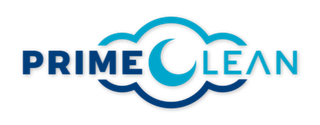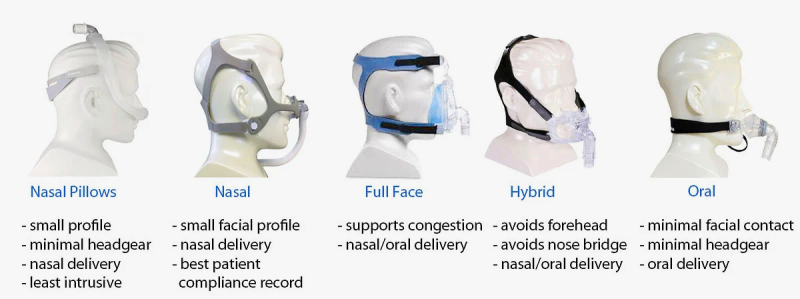What Is The Best CPAP Machine Mask For You?
Nov 11, 2021 by PrimeClean
What type of CPAP machine mask is the best for you? Should you consider buying a CPAP pillow? Do CPAP mask straps cause you problems and how you can resolve this? Sleeping with CPAP doesn’t have to be a nightmare. There are a lot of answers and solutions to the questions we asked above... Read the following article to get more information on what you can do to make life with CPAP more comfortable.
Sleeping With CPAP
CPAP machine is a medical device used in sleep apnea treatment. CPAP stands for Continuous Positive Airway Pressure, and it’s a name that is used to describe a therapy for treating sleep apnea (therapy was developed by Dr. Colin Sullivan in 1980. and since then it has proven to be overall the best solution for obstructive sleep apnea condition). Every CPAP machine contains 3 main parts: a motor (the machine itself), a hose, and a mask. Other parts are air filter(s), humidifier, mask straps, tube connectors (some of the other parts might not be listed with all machines, but mostly it is the 4 we mentioned). It is used by wearing a face mask that is connected to the CPAP machine with a hose. As it is a sleep treatment, it is mainly used at night, during the sleeping period, and being a bit bulky it can be a bit annoying…and it definitely takes some time getting used to it.
There are ways to make sleeping with a CPAP a more comfortable experience! For start, there are different CPAP machine mask types, specially designed CPAP pillow, CPAP strap covers… Let’s dive deeper into the subject and see what can you do to get some quality sleep with CPAP on.
Types of Face Masks
Probably the key question, when talking about comfort, is which face mask suits you the best? As mentioned earlier, there are several types of CPAP machine masks, and they mostly differ in size i.e. area of the face they cover. So we have masks from covering the entire face (full-face masks) to minimalist (under-nose masks).
In general, we can divide CPAP machine masks into 3 types: full-face, nasal, and nasal pillow masks.
Full face mask, as the name suggests covers most of the face. It is the biggest mask type and covers both mouth and nose. This is the most common CPAP mask and many find it to be the most comfortable and practical. Although it is heavier and bulkier than other masks, it does offer the best seal (with an exception for people with more facial hair) and it is suitable for both mouth and nose breathers. The main issue with this mask comes from its bulkiness and size…it doesn’t allow too much motion or position changes during sleep. It is mostly suited for back sleepers (it is suitable for side slippers as well if combined with special CPAP pillows). Also, since it covers a bigger area and has bigger contact with the face, it can be problematic for people who have easily irritated skin.
Nasal mask, is a smaller “cousin” of the full face mask. Usually, with a similar design as the full face mask, just significantly smaller, nasal mask covers only the nose. They are an ideal choice for people who breathe through the nose and like sleeping on the side or tossing and turning during sleep. As full face masks, they are fixed with mask straps. Although it doesn’t cover the mouth, which is problematic for people occasionally breathing through their mouth, they are gaining huge popularity recently since many opt in to use chin strap which keeps their mouth closed. The downside of these masks is that it is difficult to use when having nasal congestion (so it’s a “no” for anyone who has frequent allergy issues), a nose injury, or a deviated septum.
Nasal pillow mask, comes as the upgraded solution to the nasal mask. This mask, contrary to the previous 2 masks, does not cover any part of the face. The nasal pillow mask sits right under the nose and uses silicone pads that fit just inside the nostrils. It is the ideal solution for anyone with facial hair, as well as for those who like sleeping on the side since these masks, same as nasal masks, allow a lot more freedom of movement during sleep. This mask however won’t be an ideal choice for CPAP users who are prescribed with the higher pressure settings, users with frequent nasal congestion, or allergies.
Besides above mentioned 3 typical mask types, there are a few more special CPAP machine masks that we should mention… They are less often prescribed, but they have their users.
Total face mask – covers the full face from chin to forehead, covering the whole face. These masks might be prescribed in the case of patients with facial irregularities when a proper mask seal cannot be obtained.
Oral masks – opposite to nasal masks, oral masks cover only the mouth. These are usually used when users have deviated septum or any similar issue with nose breathing, and for some reason cannot tolerate the full face mask, or simply find this mask as the better alternative due to its minimalistic design.
Hybrid masks – as suggested by its name, a hybrid mask is the combination (hybrid) of two mask types (most often combining the full face mask and nasal pillow mask, or even oral and nasal pillow mask).
Different manufacturers offer different masks. Big players in the CPAP industry often offer more than one option for the CPAP mask… You can read more about the best CPAP masks in 2021. in PrimeClean Blog, here. Selecting a perfect mask is usually something that comes with the suggestion of the prescribing doctor. It may seem like an easy decision, of course at first glance everyone would pick the smallest, lightest mask possible, but unless the mask does what it’s used for, the comfort of it doesn’t play the key role. So, keep in mind that the mask’s primary function is to enable prescribed air inflow pressure and, at least “good enough”, seal. Once you satisfy this requirement, you can start the quest for perfect comfort.
CPAP Pillow – A Perfect Solution For Side Sleepers
Specially designed for CPAP users, to fit the CPAP mask and hose, CPAP pillow is often the perfect solution for CPAP users who are side sleepers. Having CPAP mask on during sleep in some cases limits the position in which the user can sleep (patients that use full face mask are mostly limited to back sleeping position; other masks might allow sleeping on the side, but still the hose might cause some issues with the regular pillow). Its unique design and shape, with dents and cuts, is created in such a way that it follows the CPAP mask and tube/hose, making it a perfect fit. CPAP pillow manufacturers usually have a more medical approach to the design and materials, so the pillows are often with memory foam, more than one layer of hardness, different height and width…and for different occasions 8travel pillow, bedroom pillow…). With the variety of pillow designs, this is an accessory every CPAP user should consider buying, it’s an investment in a good night’s sleep.
Getting Used To Mask Straps
CPAP mask is held (firmly) in place with the headgear i.e. mask straps that wrap around the back of your head. Most CPAP machine masks come with straps made from elastic and soft material. However, some don’t. If mask straps are causing face irritation issues, or leave imprints every time you use the CPAP, first you need to check and make sure straps are not too tight. If straps are set correctly (making them too loose might affect mask seal to the face) but you still experience issues, a cheap and simple solution is using CPAP strap covers. Strap covers are a soft, hypo-allergenic, simple-to-use, cheap solution that will in most cases resolve the strap problems.
CPAP Masks Need To Be Maintained And Replaced On Time
Keeping your CPAP mask cleaned and sanitized is a must! Not only that regular sanitizing will keep your mask clean and healthy (if not cleaned regularly, your mask becomes a home to all sorts of germs and mold), but it will keep it functioning properly longer (mineralization shortens masks lifetime significantly).
According to Sleep Foundation, the CPAP mask should be replaced in 3-6 months! And if possible it should be cleaned on daily basis. To avoid the hustle of cleaning and drying it manually, the best solution we recommend would be using the CPAP Cleaner device (gets the job done in 30 minutes with a simple click on the button).
Sleeping With CPAP Should Be Comfortable
Sleep apnea treatments have come a long way since CPAP therapy was first discovered. The use of CPAP, although is perceived as uncomfortable and scary to many starters, just takes time to get used to and a little research on how to help yourself overcome the problems that sleeping with the mask and headgear on. The CPAP industry is developing more every year and the rising demands of the market push manufacturers to make more adjustments to the equipment, to make it more comfortable, to offer more options, to help users maintain the quality of life they gain with CPAP therapy.
Sleeping with CPAP doesn’t have to be a nightmare...comfort and a good night’s sleep are right there, with some small effort and research, everyone could reach out and get it.






